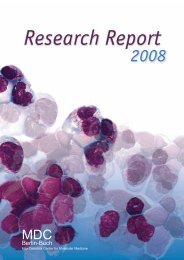iMDC03 zum Download (pdf)
iMDC03 zum Download (pdf)
iMDC03 zum Download (pdf)
Erfolgreiche ePaper selbst erstellen
Machen Sie aus Ihren PDF Publikationen ein blätterbares Flipbook mit unserer einzigartigen Google optimierten e-Paper Software.
miTeinander, nicht nebeneinander<br />
„Das deutsche Wissenschaftssystem ist zu versäult.“ Diese Generalkritik am angeblichen<br />
Nebeneinander von universitärer und außeruniversitärer Forschung höre ich immer wieder.<br />
Unser Forschungszentrum ist der lebendige Beweis dafür, dass wir längst ein Miteinander<br />
pflegen.<br />
Im aktuellen „Förderatlas 2012“ der Deutschen Forschungsgemeinschaft liegt das MDC<br />
mit 17,1 Mio. Euro bundesweit auf Platz 2 (zusammen mit dem Helmholtz-Zentrum München).<br />
Diese Mittel sind größtenteils über koordinierte Programme wie Sonderforschungsbereiche<br />
(SFB), SFB/Transregios oder Schwerpunktprogramme gemeinsam mit Universitätswissenschaftlern<br />
eingeworben worden. Uns verbinden 19 Sonderprofessuren mit der Charité, mit<br />
der wir auch sehr erfolgreich das Experimental and Clinical Research Center (ECRC) betreiben.<br />
Über das Berlin Institute for Medical Systems Biology und das Integrative Forschungsinstitut<br />
(IRI) für Lebenswissenschaften sind wir stark mit der Humboldt-Universität vernetzt, ebenso<br />
bestehen enge Beziehungen zur Freien Universität. Und unsere rund 350 Doktoranden, von<br />
denen die meisten den Titel „Dr. rer. nat.“ anstreben, sind an einer der Berliner Universitäten<br />
eingeschrieben.<br />
Alles im Lot also? Nicht ganz, denn die Unis sind chronisch unterfinanziert, und viele<br />
Länder werden nicht die Mittel haben, um nach Auslaufen der Exzellenz-Initiative etwa<br />
Cluster weiter zu finanzieren. Jetzt besteht die Chance, mit einer gemeinsamen Einrichtung<br />
von Charité und MDC in Berlin etwas Neues zu schaffen. Wichtig ist mir dabei, dass beide<br />
Einrichtungen ihre Identität wahren, dass die Unis mit im Boot sind und, vor allem, dass<br />
universitäre und außeruniversitäre Kollegen sich auf Augenhöhe begegnen. Denn nur dann<br />
kann man voneinander lernen.<br />
With Each OthEr, not alongsiDe eaCh other<br />
“The German science system is constrained by its two-pillar structure.” This general criticism<br />
of the perceived parallel structure of university and non-university research in Germany – with<br />
researchers working alongside each other instead of with each other – is a comment I hear<br />
often. However, our research center is living proof that the two pillars have a long history of<br />
cooperation with each other.<br />
With grants totaling EUR 17.1 million, the MDC ranked second place (together with Helmholtz-<br />
Zentrum München) nationwide in the most recent funding ranking of the German Research<br />
Foundation (Förderatlas 2012). These funds have largely been acquired by coordinated programs<br />
such as collaborative research centers (SFBs), cross-regional collaborations (SFBs/Transregios) or<br />
priority programs together with university scientists. No less than 19 special professorships link<br />
us to the Charité, with which we also successfully operate the Experimental and Clinical Research<br />
Center. Through the BIMSB and the Integrative Research Institute (IRI) for the Life Sciences, we<br />
are closely interconnected with Humboldt University, and we also have close relations with the<br />
Free University of Berlin. Furthermore, our approximately 350 graduate students, most of whom<br />
are pursuing a “Dr. rer. nat.” degree, are enrolled at one of Berlin’s universities.<br />
Is then everything as it should be? Not really, because the universities are chronically underfunded,<br />
and many states will not have the resources to finance research clusters once the<br />
Excellence Initiative has expired. The proposed institutional cooperation between the Charité<br />
and the MDC now offers the opportunity to create something new in Berlin. What is important to<br />
me is that both institutions retain their identity, that the universities are on board as well and,<br />
most essential, that the university and non-university research colleagues work together on an<br />
equal footing – only then can we learn from each other.<br />
Thomas Sommer<br />
sTandpunkT perspeCtive<br />
imdc03 2012<br />
3
















